ВУЗ: Казахская Национальная Академия Искусств им. Т. Жургенова
Категория: Книга
Дисциплина: Не указана
Добавлен: 03.02.2019
Просмотров: 17252
Скачиваний: 51
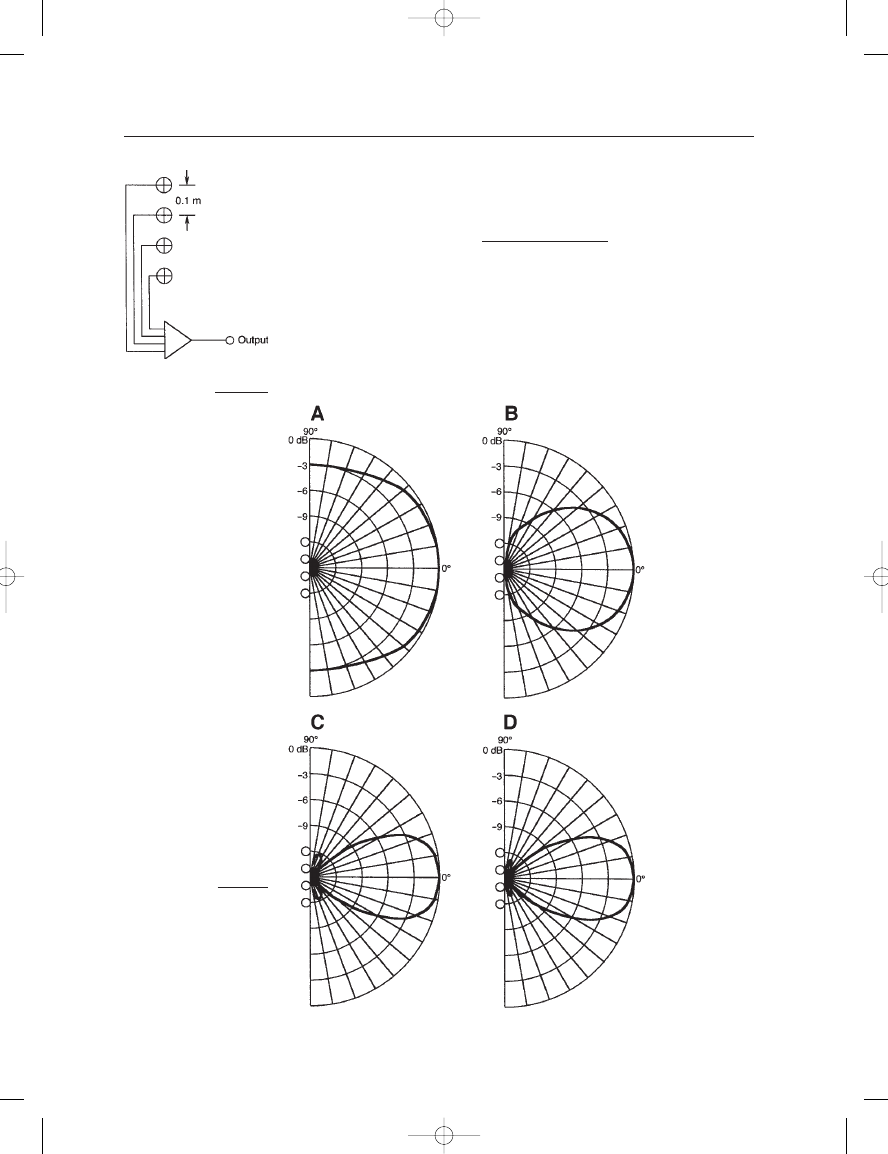
(4 in). The far-field directivity function R(
) is given by the following
equation:
(19.1)
where N
4 and d 0.1. The measurement angle is given in radians,
and k
2f/c, where c is the speed of sound in m/s.
Figure 19–2 shows directivity plots in the vertical plane for the
four-element array at frequencies of 400 Hz, 700 Hz, 1 kHz and 2 kHz.
A plot of the directivity factor of the array is shown in Figure 19–3 by
R(
)
sin
(1/2
Nkd
sin
)
N
sin
(1/2
kd sin
)
19: Overview of Microphone arrays and Adaptive Systems
323
FIGURE 19–1
A four-element in-line array
of omnidirectional
microphones.
FIGURE 19–2
Far-field directional
response for a four-element
array of omnidirectional
microphones with inter-
element spacing of 0.1 m:
400 Hz (A); 700 Hz (B);
1 kHz (C); 2 kHz (D).
Earg_19.qxd 14/9/04 3:04 PM Page 323
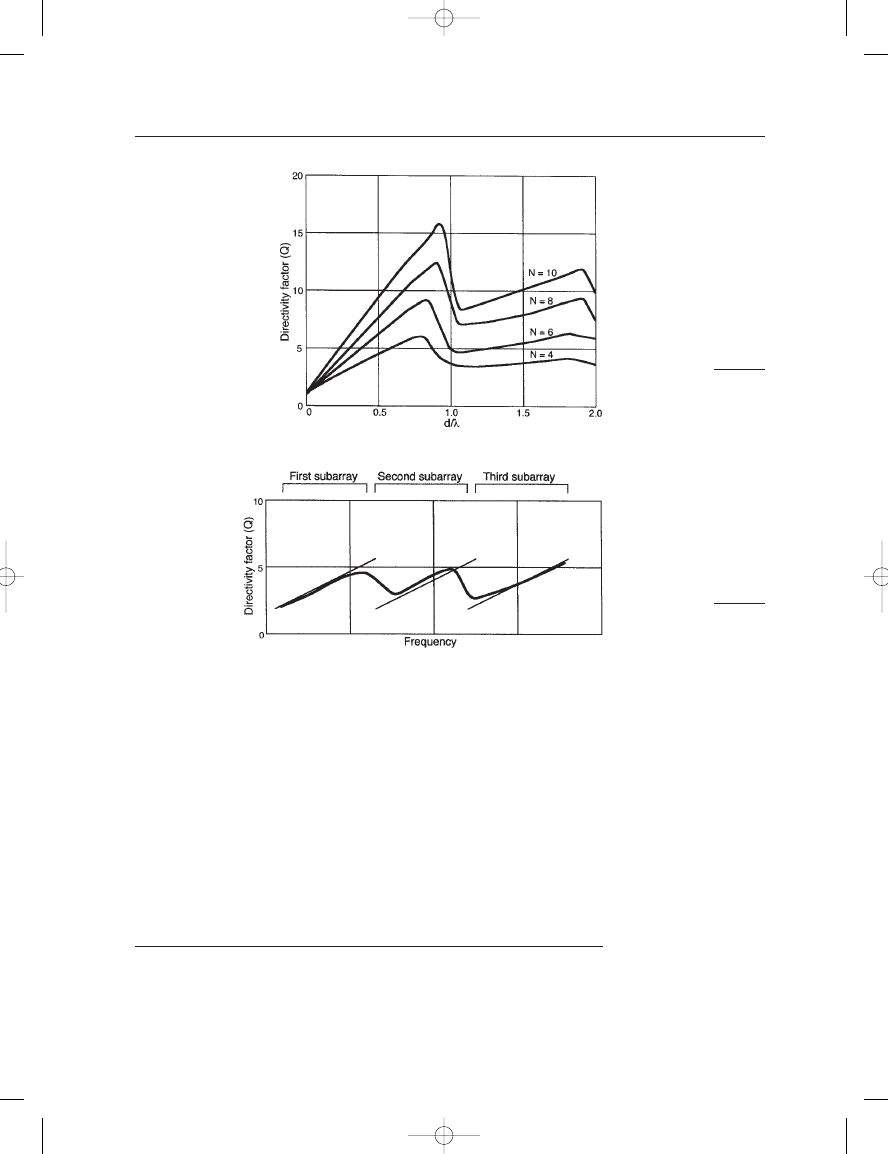
the curve marked N
4. The value of d/ 1 along the baseline of the
graph corresponds to a frequency of 3340 Hz.
The useful range of the array extends up to a value of d/
equal to
about 1. Above that point the directional pattern shows the develop-
ment of numerous off-axis lobes, although the on-axis directivity factor
remains fairly uniform. The useful range of the array can be extended
by shortening it with rising frequency. This involves having numerous
elements and crossing over from one wider-spaced set to another with
smaller spacing with increasing frequency. With careful attention to
matters of frequency division, response as shown in Figure 19–4 is
possible.
A CONSTANT-DIRECTIVITY TRANSDUCER ARRAY USING
LOGARITHMICALLY SPACED ELEMENTS
The frequency range of a directional array using logarithmically spaced
elements is more efficient in the use of a fixed number of transducers
than an array consisting of equally spaced elements. Van der Wal et al.
THE MICROPHONE BOOK
324
FIGURE 19–3
Directivity factor for
in-line arrays of 4, 6, 8 and
10 elements.
FIGURE 19–4
Extending the frequency
range of uniform coverage.
Earg_19.qxd 14/9/04 3:04 PM Page 324
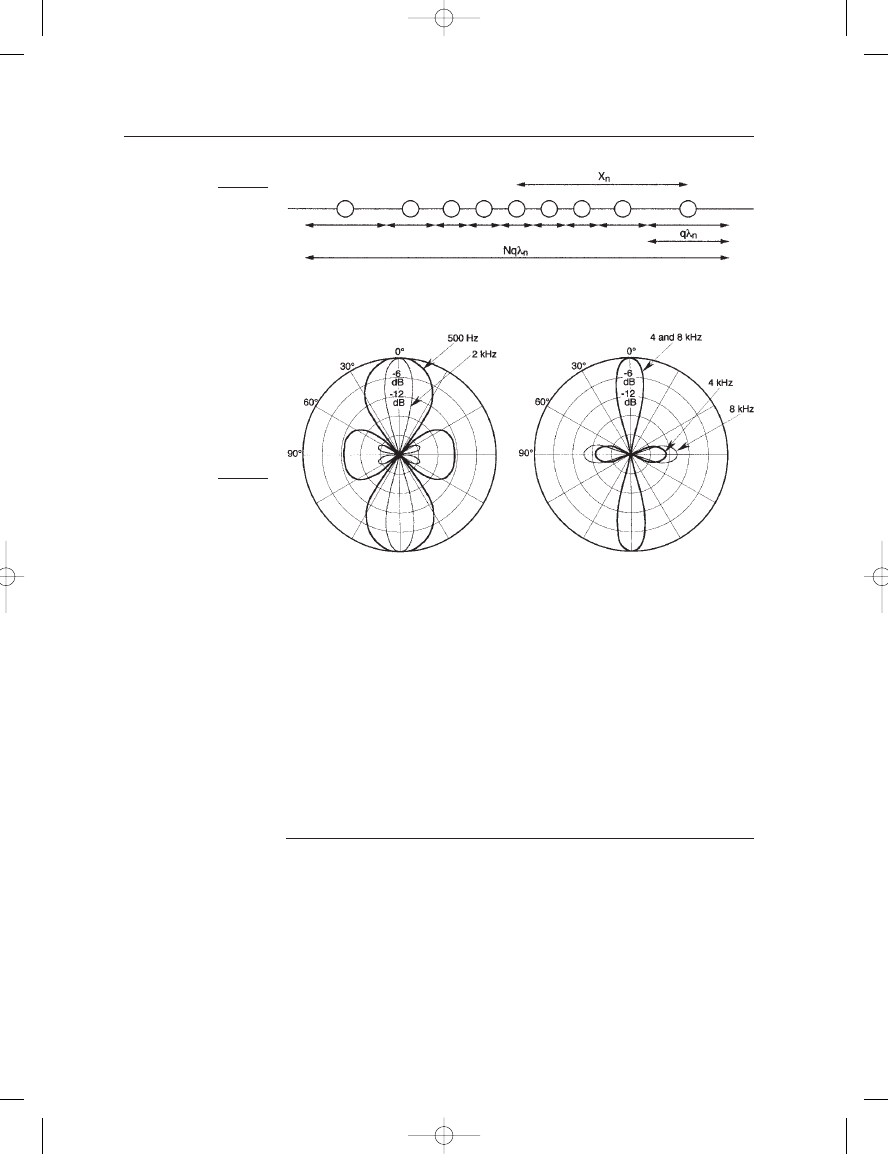
(1996) propose an array as shown in Figure 19–5. The spacing of
elements is more dense toward the center of the array, and this allows
a decreasing array size by filtering with rising frequency such that the
number of active transducers is optimized in all frequency ranges. The
directivity of the array is shown in Figure 19–6. Here, the measured
directivity over the four-octave range from 500 Hz to 8 kHz shows a
remarkably uniform central lobe, with minor lobes largely in the
20 dB
range.
MICROPHONE ARRAY FOR MULTIMEDIA
WORKSTATIONS
Mahieux et al. (1996) describe an array consisting of 11 elements placed
in a slight arc above the display screen of a multimedia workstation. The
operating distance from the microphones to the operator is about 0.7 m,
well in the near field. The purpose of the array is to pick up the voice
of the operator with a fairly uniform directivity index of 10 dB over
the frequency range from about 500 Hz to 8 kHz. The elements of the
array are grouped into four subarrays as shown in Figure 19–7. Through
appropriate filtering into four frequency bands a net directivity index is
produced as shown in Figure 19–8.
19: Overview of Microphone arrays and Adaptive Systems
325
FIGURE 19–5
A logarithmically spaced
line array of microphones
(Van der Wal et al.,
1996).
FIGURE 19–6
Polar response estimates
for the array shown in
Figure 19–5 (Van der Wal
et al., 1996).
Earg_19.qxd 14/9/04 3:04 PM Page 325
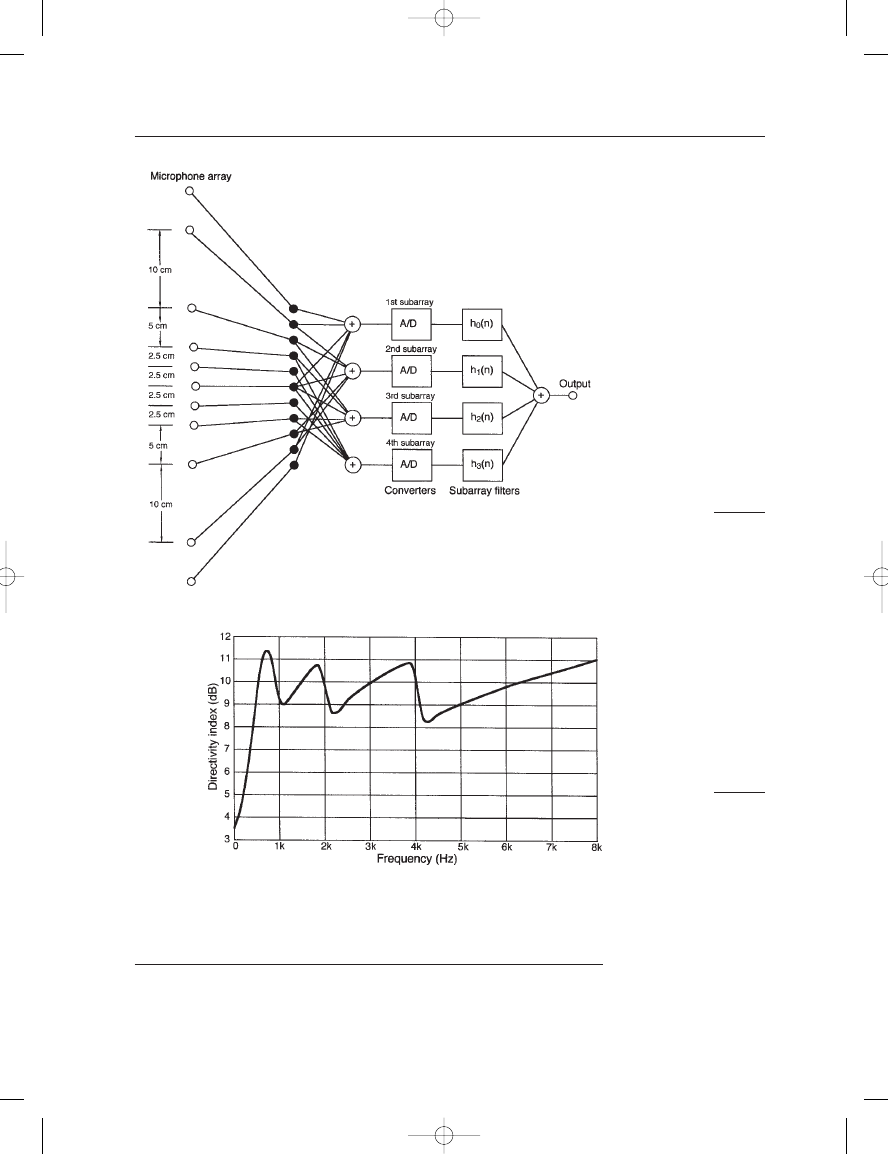
A DESK-TYPE MICROPHONE ARRAY WITH CARDIOID
HORIZONTAL RESPONSE AND NARROWED
VERTICAL RESPONSE
The German Microtech Gefell model KEM970 microphone is an exam-
ple of a fixed vertical array that produces a broad lateral cardioid pickup
pattern and a 30
(6 dB down) vertical pattern over the frequency range
THE MICROPHONE BOOK
326
FIGURE 19–7
Top view of line array
built into a multimedia
workstation (Mahieux
et al., 1996).
FIGURE 19–8
Directivity index of
the array shown in
Figure 19–7 (Mahieux
et al., 1996).
Earg_19.qxd 14/9/04 3:04 PM Page 326
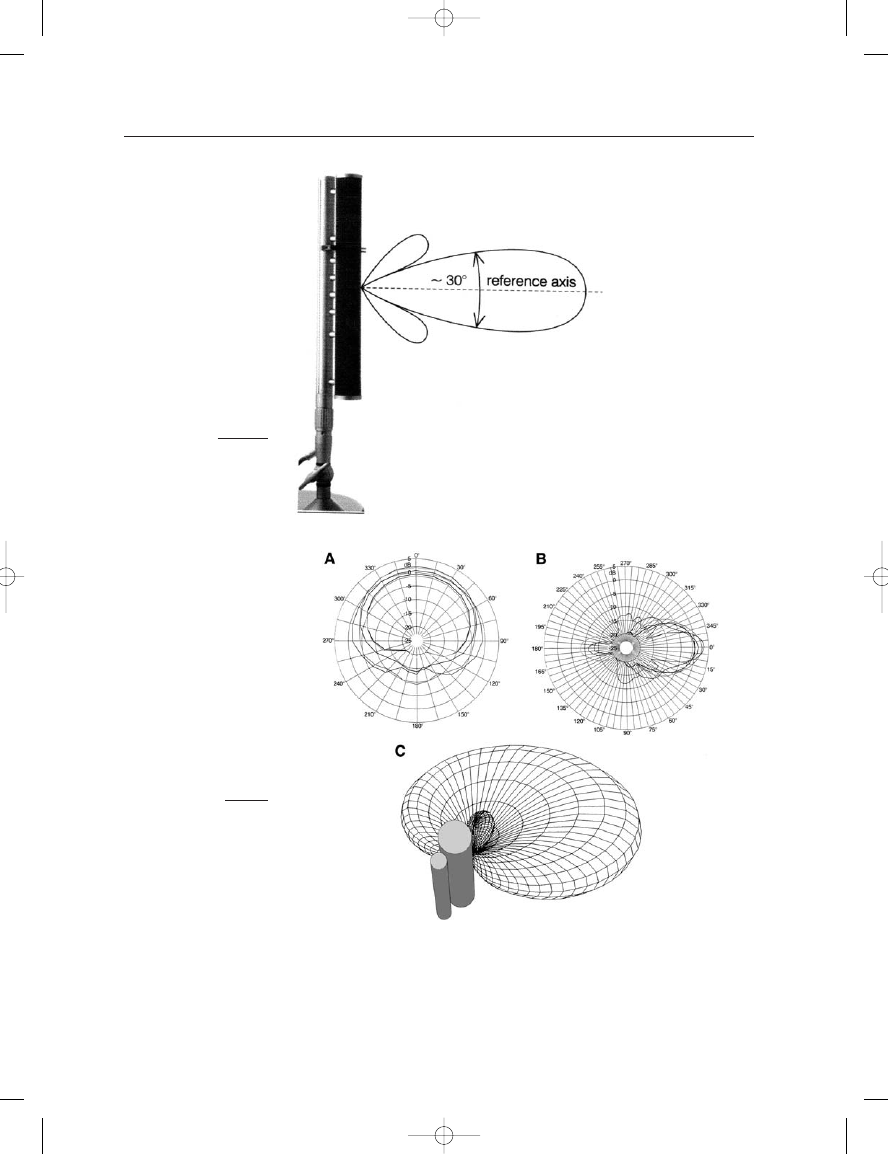
above 800 Hz, resulting in a directivity index of about 10 dB at MF and
HF. The length of the array is 0.35 m (14 in). Figure 19–9 shows a side
view of the microphone, and Figures 19–10A and B show families of
polar response. A typical “directivity balloon” for the microphone is
shown at C.
19: Overview of Microphone arrays and Adaptive Systems
327
FIGURE 19–9
Microtech Gefell KEM970
microphone. (Photo
courtesy of Cable Tek
Electronics Ltd.)
FIGURE 19–10
Microtech Gefell KEM970
microphone polar data:
horizontal polar family (A);
vertical polar family (B);
typical directivity balloon
(C). (Data courtesy of
Cable Tek Electronics Ltd.)
Earg_19.qxd 14/9/04 3:05 PM Page 327